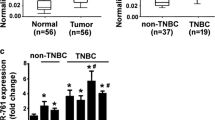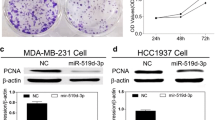Abstract
MicroRNAs (miRNAs) play a key role in tumor metastasis based on their capacity to regulate the expression of tumor-related genes. Over-expression of key genes such as c-MYC and CTNNB1 (encoding β-catenin) in Wnt/β-catenin-dependent and ROCK1 in Wnt/β-catenin-independent signaling pathways (Rho/Rho-associated kinase (ROCK) signaling pathway) has already been identified as the hallmarks of many tumors, and their role in breast cancer has also been investigated and confirmed. miR-340 characterization as an onco-suppressor miRNA has been previously reported. However, the mechanism by which it inhibits metastasis has not been completely elucidated. Quantitative real-time PCR (qPCR), Western blot, and luciferase assays were used to confirm the effect of miR-340 on the 3′-untranslated region (UTR) of the target genes. Lentiviral particles containing miR-340 were also used to evaluate the effect of miR-340 restoration on cell proliferation, migration, and invasion in vitro in the invasive MDA-MB-231 cell line. By applying bioinformatic approaches for the prediction of miRNAs targeting 3′-UTRs of CTNNB1, c-MYC, and ROCK1, we found out that miR-340 could dramatically down-regulate metastasis by targeting Wnt signaling in breast cancer cells. In the current study, analyzing miR-340 by reverse transcription quantitative PCR (RT-qPCR) in MDA-MB-231 showed that it was remarkably down-regulated in the metastatic breast cancer cell line. We found that restoration of miR-340 in the invasive breast cancer cell line, MDA-MB-231, suppresses the expression of the target genes’ messenger RNA (mRNA) and protein and, as a result, inhibits tumor cell invasion and metastasis. Our findings highlight the ability of bioinformatic approaches to find miRNAs targeting specific genes. By bioinformatic analysis, we confirmed the important role of miR-340 as a pivotal regulator of breast cancer metastasis in targeting previously validated (ROCK1) and potentially novel genes, i.e., (CTNNB1 and c-MYC).





Similar content being viewed by others
References
Rehmsmeier M, Steffen P Fau - Hochsmann M, Hochsmann M Fau - Giegerich R, Giegerich R. Fast and effective prediction of microRNA/target duplexes. (1355–8382 (Print).
Takahashi RU, Miyazaki H, Ochiya T The roles of microRNAs in breast cancer. (2072–6694 (Electronic)
Klarmann GJ, Decker A, Farrar WL. Epigenetic gene silencing in the Wnt pathway in breast cancer. Epigenetics. 2008;3(2):59–63.
King TD, Suto Mj Fau - Li Y, Li Y The Wnt/beta-catenin signaling pathway: a potential therapeutic target in the treatment of triple negative breast cancer. J cell Biochem (1097–4644 (Electronic)
De Boer J, Wang Hj Fau - Van Blitterswijk C, Van Blitterswijk C Effects of Wnt signaling on proliferation and differentiation of human mesenchymal stem cells. (1076–3279 (Print))
Wang YZ, Han YS, Ma YS, Jiang JJ, Chen ZX, Wang YC, et al. (2012) Differential gene expression of Wnt signaling pathway in benign, premalignant, and malignant human breast epithelial cells. Tumour Biol.
Shtutman M, Zhurinsky J Fau - Simcha I, Simcha I Fau - Albanese C, Albanese C Fau - D'Amico M, D'Amico M Fau - Pestell R, Pestell R Fau - Ben-Ze'ev A, et al. The cyclin D1 gene is a target of the beta-catenin/LEF-1 pathway. (0027–8424 (Print)
Howe LR, Brown AM. Wnt signaling and breast cancer. Cancer Biol Ther. 2004;3(1):36–41.
Brabletz T, Jung A, Reu S, Porzner M, Hlubek F, Kunz-Schughart LA. Variable beta-catenin expression in colorectal cancers indicates tumor progression driven by the tumor environment. Proc Natl Acad Sci U S A. 2001;98(18):10356–61.
Takebe N, Warren RQ, Ivy SP. Breast cancer growth and metastasis: interplay between cancer stem cells, embryonic signaling pathways and epithelial-to-mesenchymal transition. Breast Cancer Res. 2011;13(3):211.
Ryo A, Nakamura M, Wulf G, Liou YC, Lu KP. Pin1 regulates turnover and subcellular localization of beta-catenin by inhibiting its interaction with APC. Nat Cell Biol. 2001;3(9):793–801.
Lin SY, Xia W, Wang JC, Kwong KY, Spohn B, Wen Y, et al. Beta-catenin, a novel prognostic marker for breast cancer: its roles in cyclin D1 expression and cancer progression. Proc Natl Acad Sci U S A. 2000;97(8):4262–6.
Jaffe AB, Hall A. Rho GTPases: biochemistry and biology. Annu Rev Cell Dev Biol. 2005;21:247–69.
Liu S, Goldstein Rh Fau - Scepansky EM, Scepansky Em Fau - Rosenblatt M, Rosenblatt M Inhibition of rho-associated kinase signaling prevents breast cancer metastasis to human bone. (1538–7445 (Electronic)
Shenouda SK, Alahari SK. MicroRNA function in cancer: oncogene or a tumor suppressor? Cancer Metastasis Rev. 2009;28(3–4):369–78.
Hurst DR, Edmonds MD, Welch DR. Metastamir: the field of metastasis-regulatory microRNA is spreading. Cancer Res. 2009;69(19):7495–8.
De Cecco L, Berardi M, Sommariva M, Cataldo A, Canevari S, Mezzanzanica D, et al. Increased sensitivity to chemotherapy induced by CpG-ODN treatment is mediated by microRNA modulation. PLoS One. 2013;8(3):e58849.
Presneau N, Eskandarpour M, Shemais T, Henderson S, Halai D, Tirabosco R, et al. MicroRNA profiling of peripheral nerve sheath tumours identifies miR-29c as a tumour suppressor gene involved in tumour progression. Br J Cancer. 2013;108(4):964–72.
Das S, Bryan K, Buckley PG, Piskareva O, Bray IM, Foley N, et al. Modulation of neuroblastoma disease pathogenesis by an extensive network of epigenetically regulated microRNAs. Oncogene. 2013;32(24):2927–36.
Wu ZS, Wu Q, Wang CQ, Wang XN, Huang J, Zhao JJ, et al. (2011) miR-340 inhibition of breast cancer cell migration and invasion through targeting of oncoprotein c-Met. Cancer.
Han J, Hendzel MJ, Allalunis-Turner J. Notch signaling as a therapeutic target for breast cancer treatment? Breast Cancer Res. 2011;13(3):210.
Liu S. The ROCK signaling and breast cancer metastasis. Mol Biol Rep. 2011;38(2):1363–6.
Yamazaki D, Kurisu S, Takenawa T. Involvement of Rac and Rho signaling in cancer cell motility in 3D substrates. Oncogene. 2009;28(13):1570–83.
Lewis BP, Burge CB, Bartel DP. Conserved seed pairing, often flanked by adenosines, indicates that thousands of human genes are microRNA targets. Cell. 2005;120(1):15–20.
John B, Enright Aj Fau - Aravin A, Aravin A Fau - Tuschl T, Tuschl T Fau - Sander C, Sander C Fau - Marks DS, Marks DS Human microRNA targets. (1545–7885 (Electronic).
Dweep H, Sticht C, Pandey P, Gretz N. miRWalk—database: prediction of possible miRNA binding sites by “walking” the genes of three genomes. J Biomed Inform. 2011;44(5):839–47.
Mohammadi-Yeganeh S, Paryan M, Mirab Samiee S, Soleimani M, Arefian E, Azadmanesh K, et al. (2013) Development of a robust, low cost stem-loop real-time quantification PCR technique for miRNA expression analysis. Mol Biol Rep.
Pfaffl MW, Horgan GW, Dempfle L (2002) Relative expression software tool (REST) for group-wise comparison and statistical analysis of relative expression results in real-time PCR. Nucleic Acids Res 30 (9).
Chen Y, Zou H, Yang LY, Li Y, Wang L, Hao Y, et al. ER81-shRNA inhibits growth of triple-negative human breast cancer cell line MDA-MB-231 in vivo and in vitro. Asian Pac J Cancer Prev. 2012;13(5):2385–92.
Fernandez S, Risolino M, Mandia N, Talotta F, Soini Y, Incoronato M, et al. Verde P miR-340 inhibits tumor cell proliferation and induces apoptosis by targeting multiple negative regulators of p27 in non-small cell lung cancer.
Cimino D, De Pitta C, Orso F, Zampini M, Casara S, Penna E, et al. miR148b is a major coordinator of breast cancer progression in a relapse-associated microRNA signature by targeting ITGA5, ROCK1, PIK3CA, NRAS, and CSF1. FASEB J. 2013;27(3):1223–35.
Kang L, Mao J Fau - Tao Y, Tao Y Fau - Song B, Song B Fau - Ma W, Ma W Fau - Lu Y, Lu Y Fau - Zhao L, et al. MiR-34a suppresses the breast cancer stem cell-like characteristics by downregulating Notch1 pathway.
Wang Y. Wnt/Planar cell polarity signaling: a new paradigm for cancer therapy. Mol Cancer Ther. 2009;8(8):2103–9.
Reya T, Clevers H. Wnt signalling in stem cells and cancer. Nature. 2005;434(7035):843–50.
Smalley MJ, Dale TC. Wnt signalling in mammalian development and cancer. Cancer Metastasis Rev. 1999;18(2):215–30.
Boras-Granic K, Wysolmerski JJ. Wnt signaling in breast organogenesis. Organogenesis. 2008;4(2):116–22.
Matsuda Y, Schlange T, Oakeley EJ, Boulay A, Hynes NE. WNT signaling enhances breast cancer cell motility and blockade of the WNT pathway by sFRP1 suppresses MDA-MB-231 xenograft growth. Breast Cancer Res. 2009;11(3):R32.
Ridley AJ. Rho GTPases and cell migration. J Cell Sci. 2001;114(Pt 15):2713–22.
Lee DY, Jeyapalan Z Fau - Fang L, Fang L Fau - Yang J, Yang J Fau - Zhang Y, Zhang Y Fau - Yee AY, Yee Ay Fau - Li M, et al. Expression of versican 3'-untranslated region modulates endogenous microRNA functions. (1932–6203 (Electronic)).
Wu ZS, Wu Q, Wang CQ, Wang XN, Huang J, Zhao JJ, et al. miR-340 inhibition of breast cancer cell migration and invasion through targeting of oncoprotein c-Met. Cancer. 2011;117(13):2842–52. doi:10.1002/cncr.25860.
Acknowledgments
The authors should thank colleagues in Cellular and Molecular Biology Research Center, Shahid Beheshti University of Medical Sciences, Tehran, Iran, Orleigh Bogle, and Vahid Kia for kindly revising of the manuscript and also Stem Cell Technology Research Center, Tehran, Iran, for technical help. This work was supported by Pasteur Institute of Iran, Tehran, Iran [grant number BP-8698], and Stem Cell Technology Research Center, Tehran, Iran [grant number 302].
Author information
Authors and Affiliations
Corresponding authors
Ethics declarations
Conflicts of interest
None
Electronic supplementary material
Below is the link to the electronic supplementary material.
Supplementary Table 1
The sequence of primers for 3’-UTRs cloning in psi-CHECK2® vector. Overhangs of MluI and NotI enzymes are underlined. (DOC 28 kb)
Rights and permissions
About this article
Cite this article
Mohammadi-Yeganeh, S., Paryan, M., Arefian, E. et al. MicroRNA-340 inhibits the migration, invasion, and metastasis of breast cancer cells by targeting Wnt pathway. Tumor Biol. 37, 8993–9000 (2016). https://doi.org/10.1007/s13277-015-4513-9
Received:
Accepted:
Published:
Issue Date:
DOI: https://doi.org/10.1007/s13277-015-4513-9




